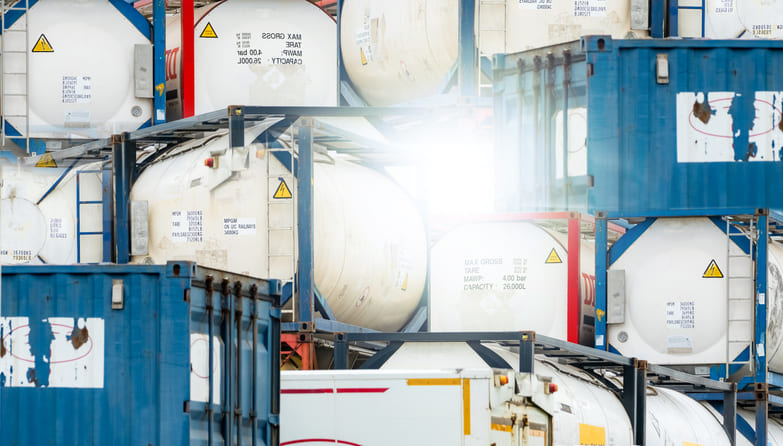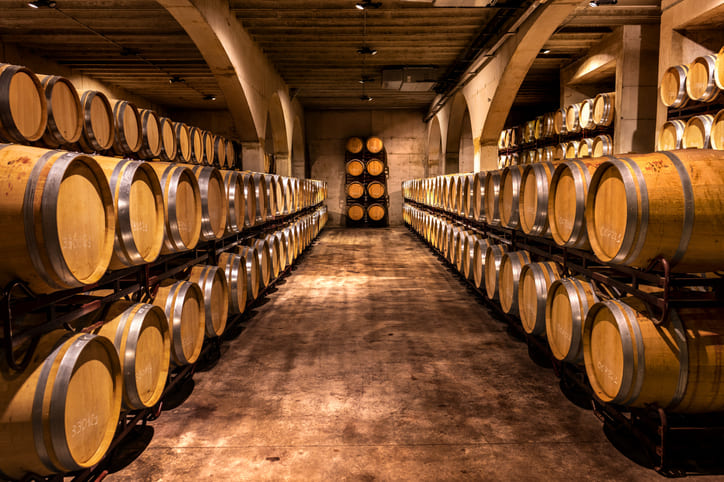Transportation of Goods: Finding the Best Solution for your wine
Table of contents
- Transportation of goods: Which shipping mode is best?
- Sea freight: The go-to option for global cargo shipping
- Air freight: The speedy choice for urgent, valuable and perishable cargo
- Rail freight: Dependable, green and fast overland
- Road transportation: Where it all begins and ends
- The ‘best’ mode for the transportation of goods depends on your priorities
When it comes to the transportation of goods, there are many ways to get your cargo to its destination.Products can travel over land by road or rail, cross vast oceans and seas on cargo ships and jet through the air on freight carrier planes.
The question we’re often asked is: Which mode of transportation is best for transporting my goods?
Transportation of goods: Which shipping mode is best?
Usually, a cargo journey is multimodal, combining different modes of transportation to reach a recipient.
At the very start and very end of the process, they’ll most likely move via road, but what about the middle?
In deciding how your cargo freight is shipped, there are always one or several core modes for the transportation of goods to choose from, and you must consider how your package will travel for the largest chunk(s) of time.
Selecting a core mode of transport is a big decision, one which heavily impacts factors like:
- Speed of delivery
- Cost of shipping
- Delay/damage risk
- Environmental impact
Each mode of transport has its advantages and drawbacks, which we’ll explore now.
Sea freight: The go-to option for global cargo shipping
Let’s start with the mode for the transportation of goods most synonymous with moving freight — cargo ships.
In a bygone era before the dawn of aviation, the only way to get packages overseas was precisely that, over the oceans in a seaworthy vessel. To this day, packages are “shipped” no matter how they travel.
Low carbon emissions
Sea freight is still the choice for international freight shipping. It’s by far the most carbon-efficient mode of transport. Think of it this way, you could push a boat down a river, but how hard would it be to push a truck down a road… ergo, sea freight uses far less energy to get moving.
Truly global reach
By comparison, sea movements are more likely to be delayed by bad weather and can generally be the slower way to transport cargo, but what you lack in speed you certainly make up for in reach. Nowadays, you can ship cargo to almost any place by sea, as a port of entry nearby is nearly always guaranteed.
Cost effective
Sea freight is highly cost-effective for any size of cargo. Large volumes of packaged goods or bulk shipments can move long distances across oceans or short distances by barge at a price often unmatched by other transport modes. In addition, smaller volumes by bottle, case and pallet or, IBC and drum, also move at attractive prices since freight forwarders can share space in their containers amongst shippers with groupage/LCL services.
Today, 90% of all goods reach their destinations via ocean routes, resulting in a giant and robust global shipping network. However, the sea freight industry is currently facing unprecedented and chaotic conditions, with port congestions, shipping container shortages, customs delays and more (read all about that on our blog here).
So, it’s worth bearing in mind that other reliable modes of transportation are also at your disposal.
Air freight: The speedy choice for urgent, valuable and perishable cargo
The only other way to move goods overseas is, of course, on a plane.
Fast delivery
When time is of the essence, air freight cargo is unsurpassed as cargo aeroplanes generally cruise at speeds approximately 900 kilometres per hour. Look at this story from a customer, when Hillebrand Gori scrambled into action to fly 100 tons of French wine to New York in less than a week!. What’s more, cargo planes usually travel on direct flight paths, and there is zero risk of a traffic jam in the sky which also adds to their uncompromised speediness of delivery. The trade-off of this ,though, is the cost of air freight, both financial and environmental; being the most expensive mode for the transportation of goods and the biggest generator of carbon emissions.
Low risk
That said, air is an extremely low-risk mode of transport. In terms of product, perishable items have a limited shelf-life, and high-value goods require tight security measures, making both of them ideal candidates for air freight. Regarding packaging, damages are less likely to occur once en route as flight paths can quickly be adapted in bad weather and with far more ease than other logistics transport modes.
Any quantity
It also sometimes surprises people to know that you can move large quantities of freight cargo by air. Planes can be fully chartered with larger freighters carrying up to a massive 110 tonnes. This type of shipment is rare but possible nonetheless, though most shippers opt for a space in the hold, paying for only their portion of the flight.
Rail freight: Dependable, green and fast overland
If the delivery trajectory is over land, rail freight is an underrated mode for the transportation of goods. It’s surprisingly fast, safe, reliable and faces few delays.
Reliable
When planning the transportation of your cargo, the single most crucial factor is nearly always meeting its required delivery date. So choosing a mode of logistics transport that promises reliability is a key factor, and rail freight transport offers just that. Trains are mostly unaffected by weather conditions, railway authorities tightly control capacity on the tracks, so you’ll never experience a traffic jam. There is also little cause for stops en route, and most service is direct to destination.
Eco-friendly
Moreover, rail freight transport is an environmentally-considerate option for in-land cargo movements. Why? By using electricity to operate, trains emit minimal CO2 levels, so carrying large cargo loads across many carriages and at long distances is greener than other transport modes.
High security
Where rail freight transport also comes into its own is the levels of security it provides for the cargo it carries. Old movies and historical tales depict great train robberies and the theft of the goods they carry as easy pickings. When in fact, it is quite the opposite. Theft from cargo trains is very rare. Railways and freight terminals are highly secure spaces with low rates of criminal activity and, therefore, the safest way to transport your goods over land.
Streamlined operations
Inland transportation of goods requires a crossover with road freight transport at some point. Either at the beginning or end of the cargo’s journey or both. What you might not be aware of, though, is that Hillebrand Gori uses multimodal containers, which significantly reduce the handling of your product to minimize any accidental damage. How do they do that? Once packed, your goods will sit safely inside their container until delivery, without the need to unload/reload, so that it can transfer between road and rail. The container can be lifted directly from train to truck or vice-versa.
Road transportation: Where it all begins and ends
The second most common way to transport your goods is by road, and hands down, the easiest and quickest way to handle domestic deliveries. Fun fact: three-quarters of Europe’s inland freight moves by road.
Integral transportation of goods
Every logistical movement of goods requires road transportation, albeit for part of the journey, if not for all of it. So not only is it the second most common mode for the transportation of goods, it is the number one most required mode of transport. Like sea freight, it can offer freight payers full container load and groupage/LCL services. Though, via road, there can be more touch points involved, which can lower the cost associated with container/trailer sharing.
Reduced documentation
Road freight is also lighter on the documentation front, especially if trucks don’t cross borders. The transportation of goods by road is usually quick to action, too, as there is an abundance of hauliers with a range of vehicle sizes ready to move your cargo.
Choice of vehicle
Another benefit to road freight transport is the range of vehicles available to you. Beyond the difference in the physical size of trucks, there are an array of associated options, too; flat beds, low loaders, curtain-sided trailers, tail lifts, and container-lifts, to name a few. So whatever your capabilities for loading/unloading, size or distance, there is a road freight vehicle available for you.
The ‘best’ mode for the transportation of goods depends on your priorities
As you’ll have noticed, there’s not one single cargo shipping mode that’s better than the others. Cost and risk should be weighed according to cargo type and the urgency of the delivery while taking into consideration the current disruptions.
Get in touch to discuss how Hillebrand Gori can forward your cargo efficiently and safely to its destination.
Published 12th February 2022, updated 23rd January 2024
The transportation of goods is the process of moving products from one location to another using various modes of transport such as sea, road, air or rail. It may involve transporting products for trade, delivery to customers or distribution to various locations.
The transportation of goods is crucial for global trade and economic growth. It allows businesses to move their products to different markets, reach new customers and fulfill orders promptly. It also enables access to goods from other countries, providing consumers with more choices and competitive prices.
A freight forwarder, like Hillebrand Gori, provides expertise and specialized services in transportation logistics. They understand the different transport modes, shipping regulations and documentation requirements. This allows them to provide efficient and cost-effective solutions for moving products from one point to another.
The future of transportation will continue to be shaped by technological advancements to increase efficiency and lower emissions. This includes adopting electric and autonomous vehicles as well as using artificial intelligence for route optimization.
How can we help your business grow?
.png?sfvrsn=dc2a7a4d_4)
.png?sfvrsn=898c2b36_1)



